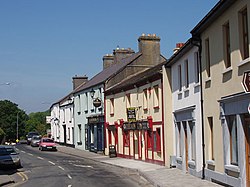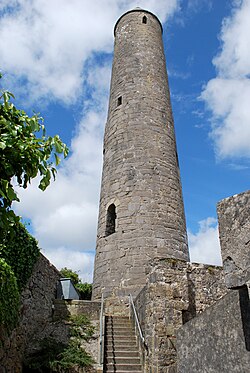Killala
| Killala Irish: Cill Ala | |
| County Mayo | |
|---|---|

| |
| Location | |
| Grid reference: | G206286 |
| Location: | 54°12’45"N, 9°13’47"W |
| Data | |
| Population: | 650 (2002) |
| Post town: | Killala |
| Postcode: | F26 |
| Local Government | |
| Council: | Ballina MD |
| Dáil constituency: |
Mayo |
Killala is a village and parish in County Mayo, to the north of Ballina. To the west of Killala, in the townland of Townsplots West, is the area known locally as Enagh Beg, which contains a number of ancient forts.
Contents
History
Killala was the site of the first battle of the French force of General Humbert in the 1798 Rebellion, which landed at nearby Kilcummin Harbour and quickly seized the town. The town was also the site of the last land battle of the rebellion on 23 September 1798 when the British army defeated a rebel Irish force in Killala. Killala was used as the major location for the 1981 multi-million-pound television series The Year of the French (based on the novel by Thomas Flanagan). In 1989 sculptor Carmel Gallagher unveiled a bust of General Humbert in the area to mark the then upcoming bicentennial of the 1798 Rebellion.[1] In 1998 Killala celebrated the bicentenary of this event by twinning with the commune of Chauvé in France and Killala has established itself as a popular location for historians.[2]
Ecclesiastical history
The Roman Catholic Diocese of Killala (Alladenis in Latin) is one of the five suffragan sees of the ecclesiastical Province of Tuam, comprising the north-western part of County Mayo with the Barony of Tireragh in County Sligo. In all there are 22 parishes, some of which, bordering on the Atlantic Ocean, consist mostly of wild moorland, sparsely inhabited. Lewis's Topographical Dictionary sets down the length of the diocese as 45 miles, the breadth 21 miles, and the estimated superficies as 314,300 acres — of which 43,100 acres are in County Sligo and 271,200 acres in County Mayo.
The foundation of the diocese dates from the time of St Patrick, who placed his disciple St Muredach over the church called in Irish Cell Alaid. In a well that still flows close to the town, beside the sea, local legend tells that Patrick baptized in a single day 12,000 converts, and on the same occasion, in presence of the crowds, raised to life a dead woman whom he also baptized. Muredach is described as an old man of Patrick's family, and was appointed to the Church of Killala as early as AD 442 or 443. His feast-day is on 12 August. It is probable that he resigned his see after a few years, and retired to end his life on the lonely island in Donegal Bay which has ever since borne his name, Inishmurray. At Killala Patrick baptized the two maidens whom he met in childhood at Focluth Wood by the western sea, and whose voices in visions of the night had often pathetically called him to come once more and dwell amongst them. He came, baptized them and built them a church where they spent the rest of their days as holy nuns in the service of God.
Little is known of the successors of Muredach in Killala down to the twelfth century. Of the sainted Bishop Cellach, for example, we learn merely that he came of royal blood, flourished in the sixth century and was murdered at the instigation of his foster-brother. His name is mentioned in Irish martyrologies. The people of Killala recall that John MacHale, Archbishop of Tuam, was a child of their diocese. He was born at Tubbernavine on 6 March 1791; became Coadjutor Bishop of Killala in 1825, bishop in 1834, and later in the same year was transferred to Tuam. He died on 7 November 1881, and is buried in the sanctuary of Tuam's cathedral. After him came Dr Finan, a Dominican priest unfit, owing to his continental training, to direct the affairs of an Irish diocese. On his resignation in 1838, a parish priest of the Archdiocese of Tuam, Rev. Thomas Feeney, who had formerly been professor and president of St Jarlath's College at Tuam, was chosen for the task of repairing the injury that ecclesiastical discipline had suffered during his thirty-five year tenure.
Along the left bank of the river are the ruins of several monasteries. Rosserk, a Franciscan house of strict observance, was founded in 1460. The Abbey of Moyne still stands on a site just over the river, and further on, north of Killala, was the Dominican Rathfran Friary. On the promontory of Errew running into Lough Conn another monastery existed as such till comparatively recent times. A round tower in Killala itself, still preserved, indicated the ancient celebrity of the place as an ecclesiastical centre.
Killala also has a Church of Ireland Cathedral, a stone building dedicated to St Patrick.
People
- Patrick McHale, recipient of the Victoria Cross
Transport
Harbour
Killala has a harbour at the south end of Killala Bay.
Roads
The main R314 road south the N26 and N59 roads in Ballina, 7½ miles to the south.
Railway
A railway line existed between 1893 and 1937.[3] This line was built under the Light Railways (Ireland) Act of 1889.[4]
Bus
A bus route serves Killala a few times a day Mondays to Fridays inclusive providing services to Ballina and Ballycastle.[5]
Notes
- ↑ "STATUES - HITHER & THITHER. Killala/Cill Ala Seaview Terrace". http://statues.vanderkrogt.net/object.php?record=ie003.
- ↑ Remembering the Year of the French: Irish Folk History and Social Memory (University of Wisconsin Press, 2007); Stephen Dunford in collaboration with Guy Beiner, In Humbert's Footstep's: Mayo 1798(Fado, 2006).
- ↑ Erris Railways – Midland Great Western Railway Stations. Mgwr.weebly.com. Retrieved on 19 June 2013.
- ↑ The Institution of Engineers of Ireland. Realizedvision.com. Retrieved on 19 June 2013.
- ↑ http://www.buseireann.ie/inner.php?id=247#Mayo
Outside links
| ("Wikimedia Commons" has material about Killala) |
- Community development in the west of Ireland: twenty years on in the Killala area. Community Development Journal 2007; 42: 330–347. Author: M.A. Brennan.
- Killala.ie – Official website for the Killala community.
- Five Pubs of Killala.
- Family history and headstones around Killala, Co. Mayo.
